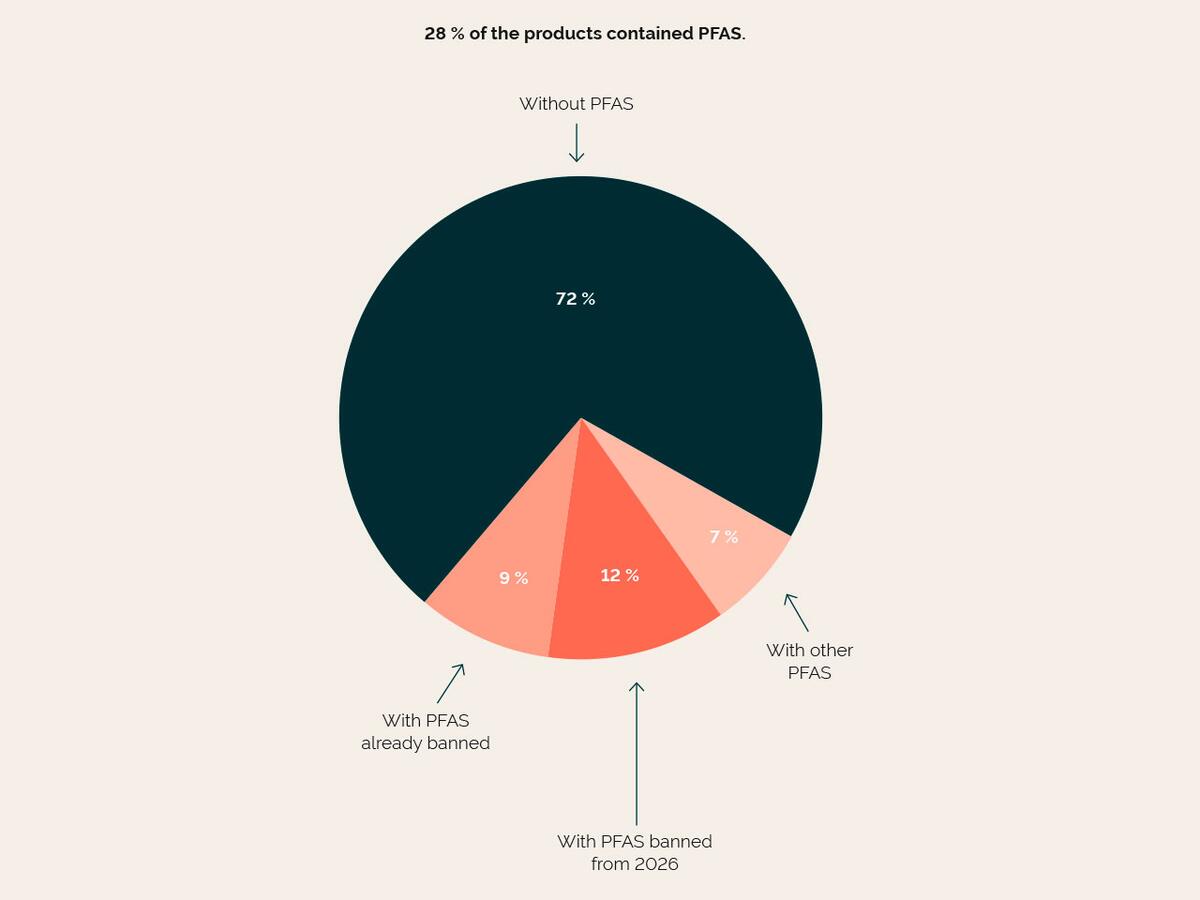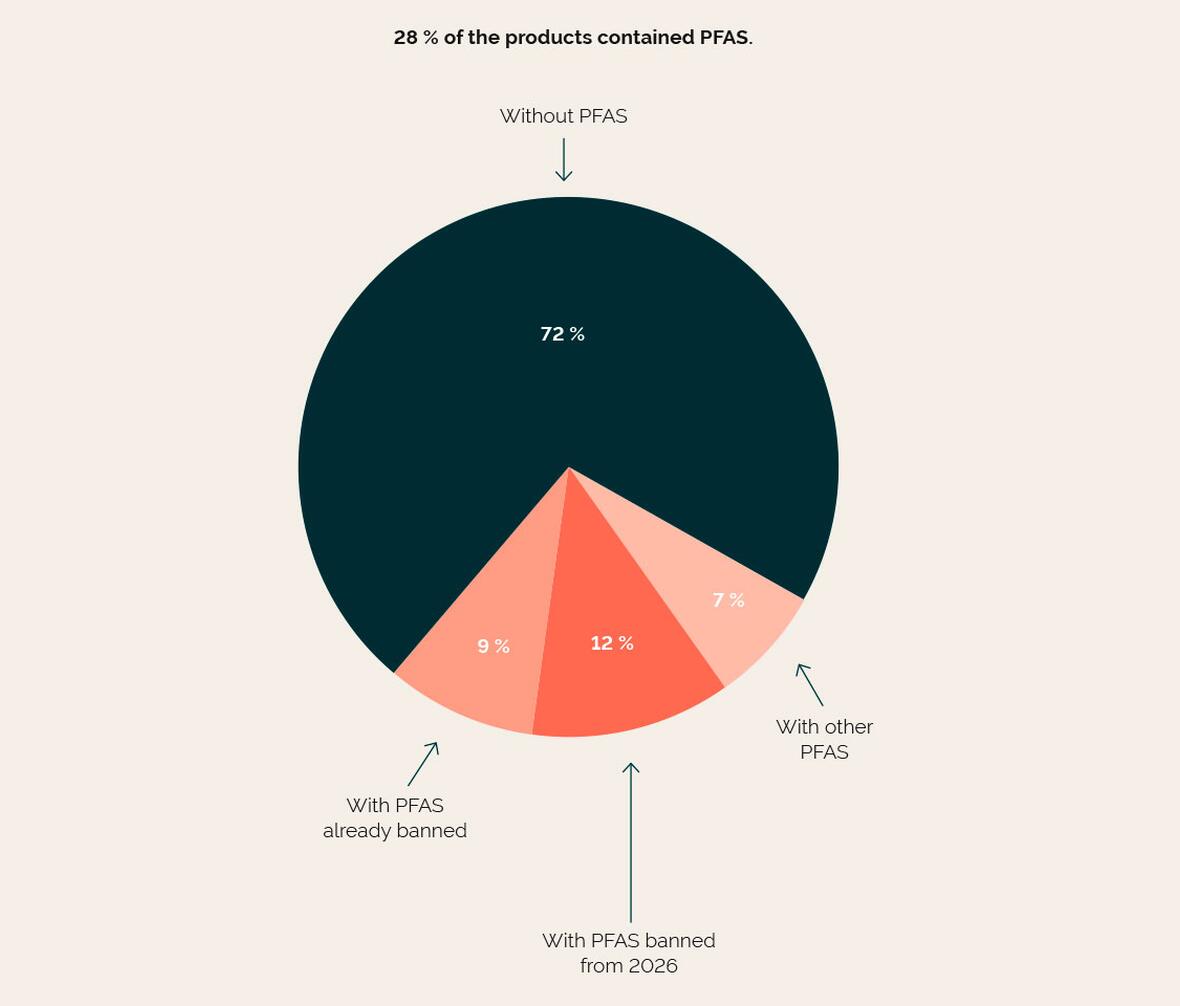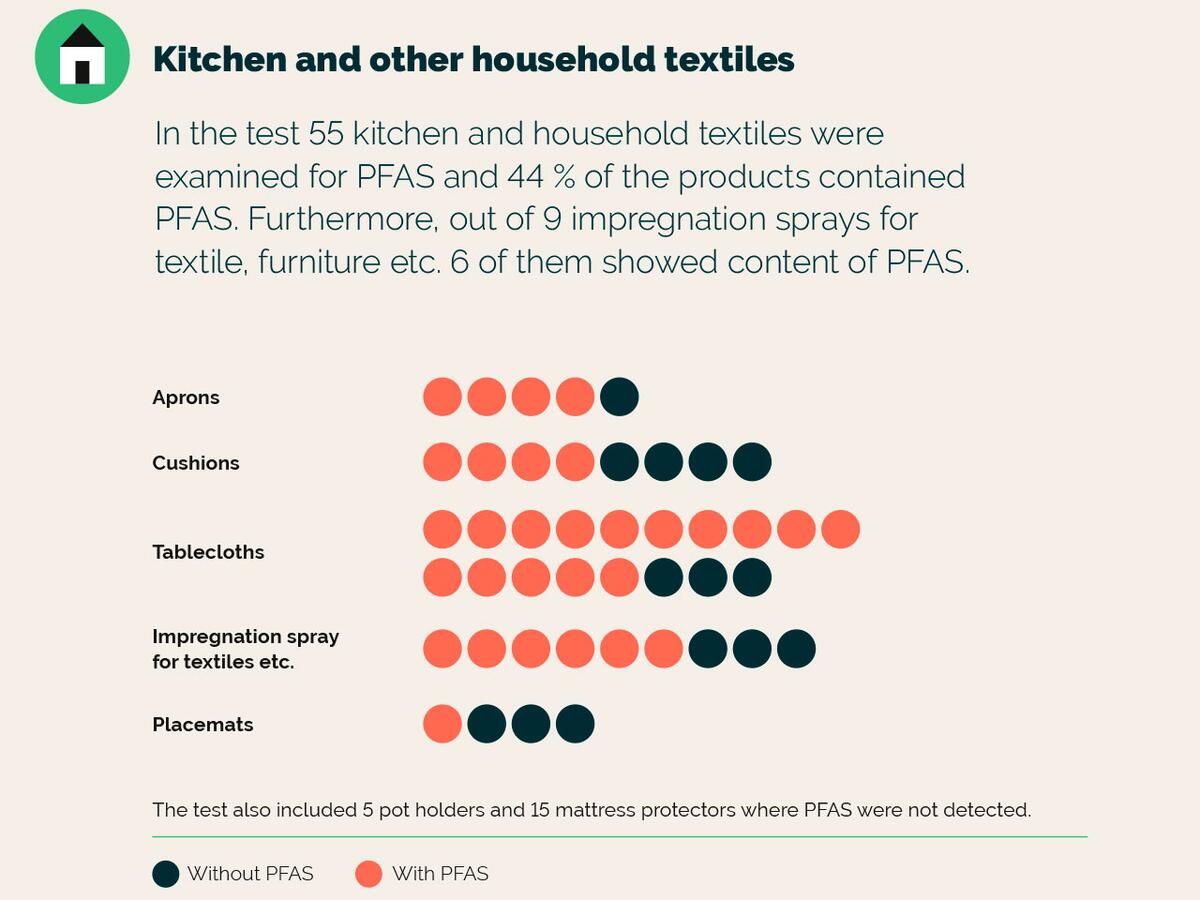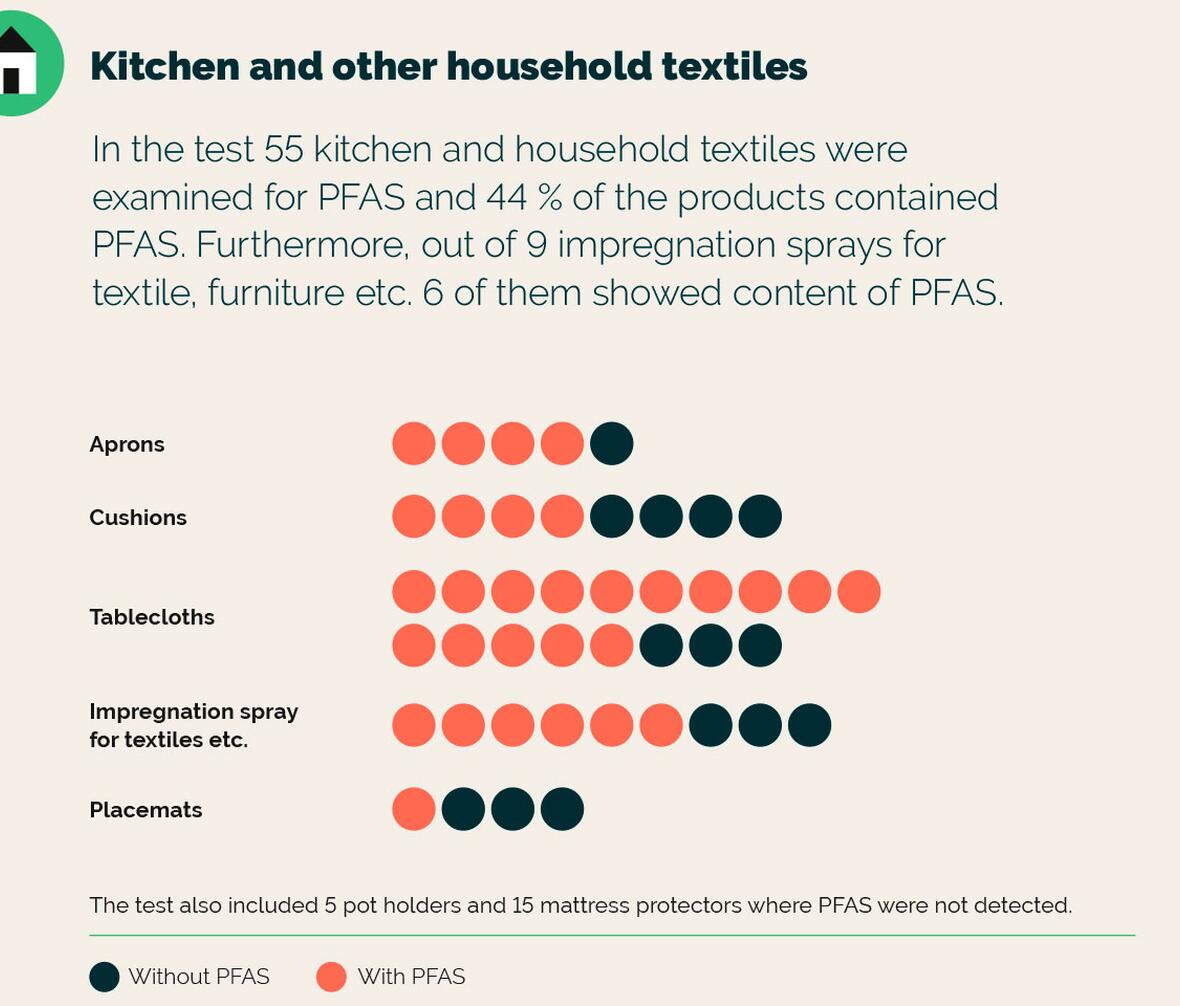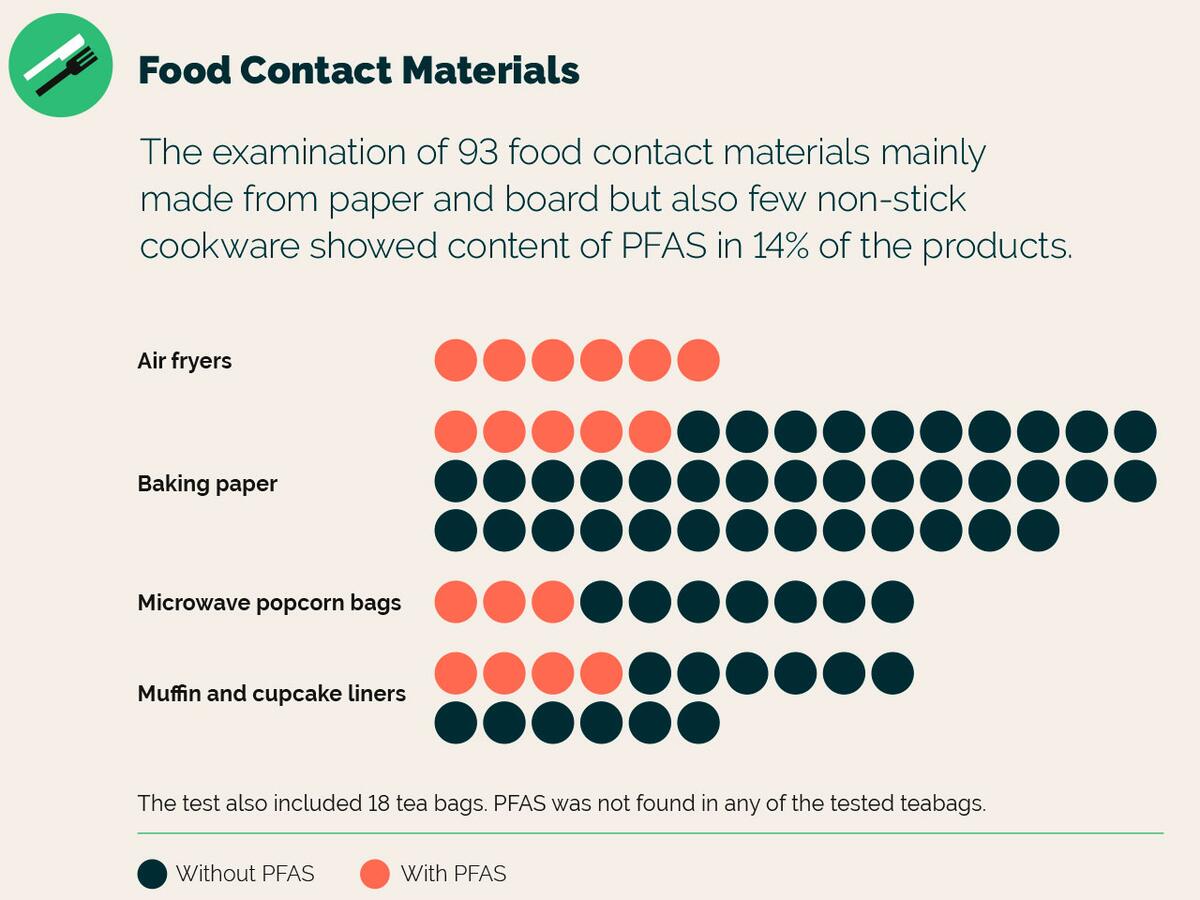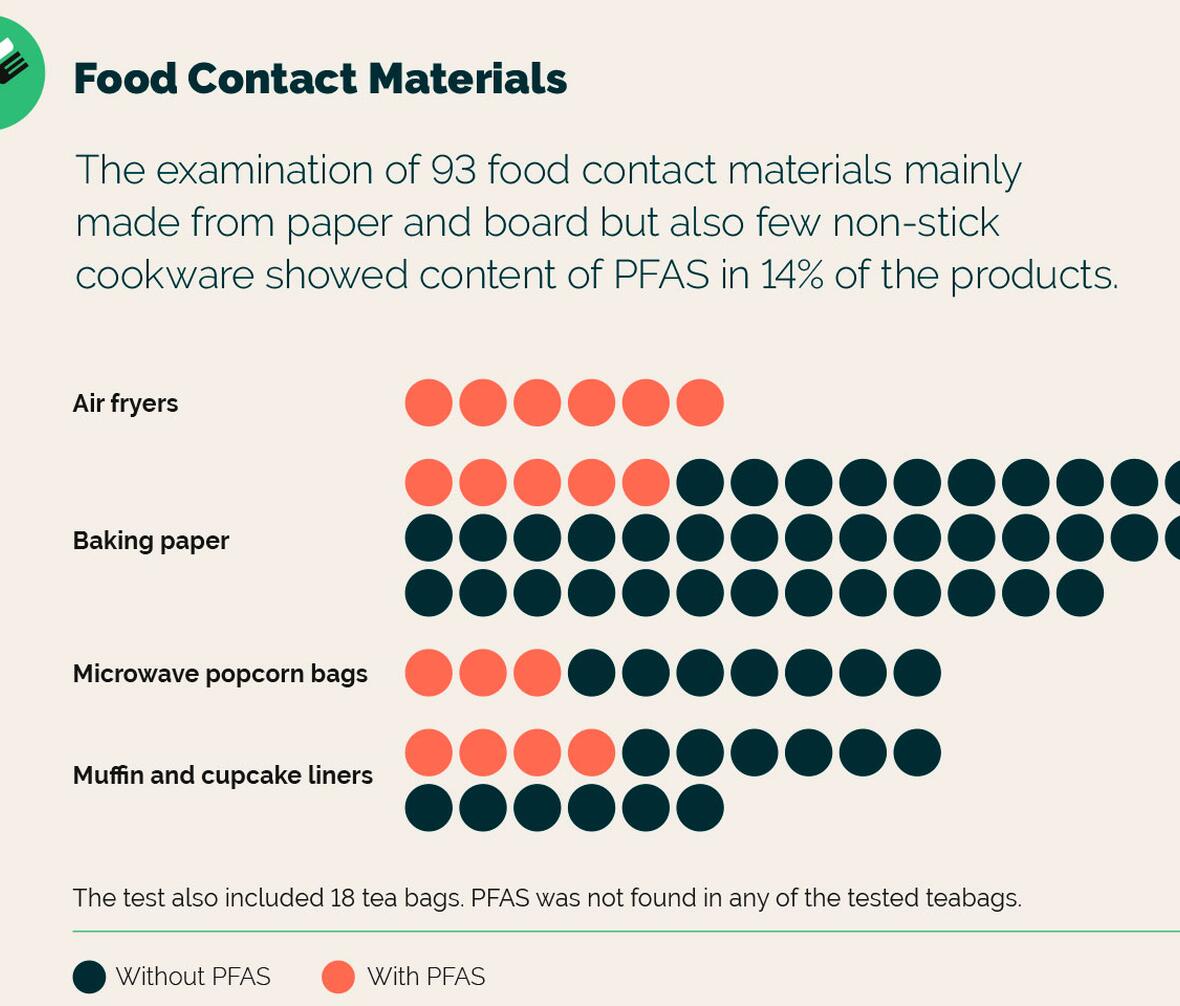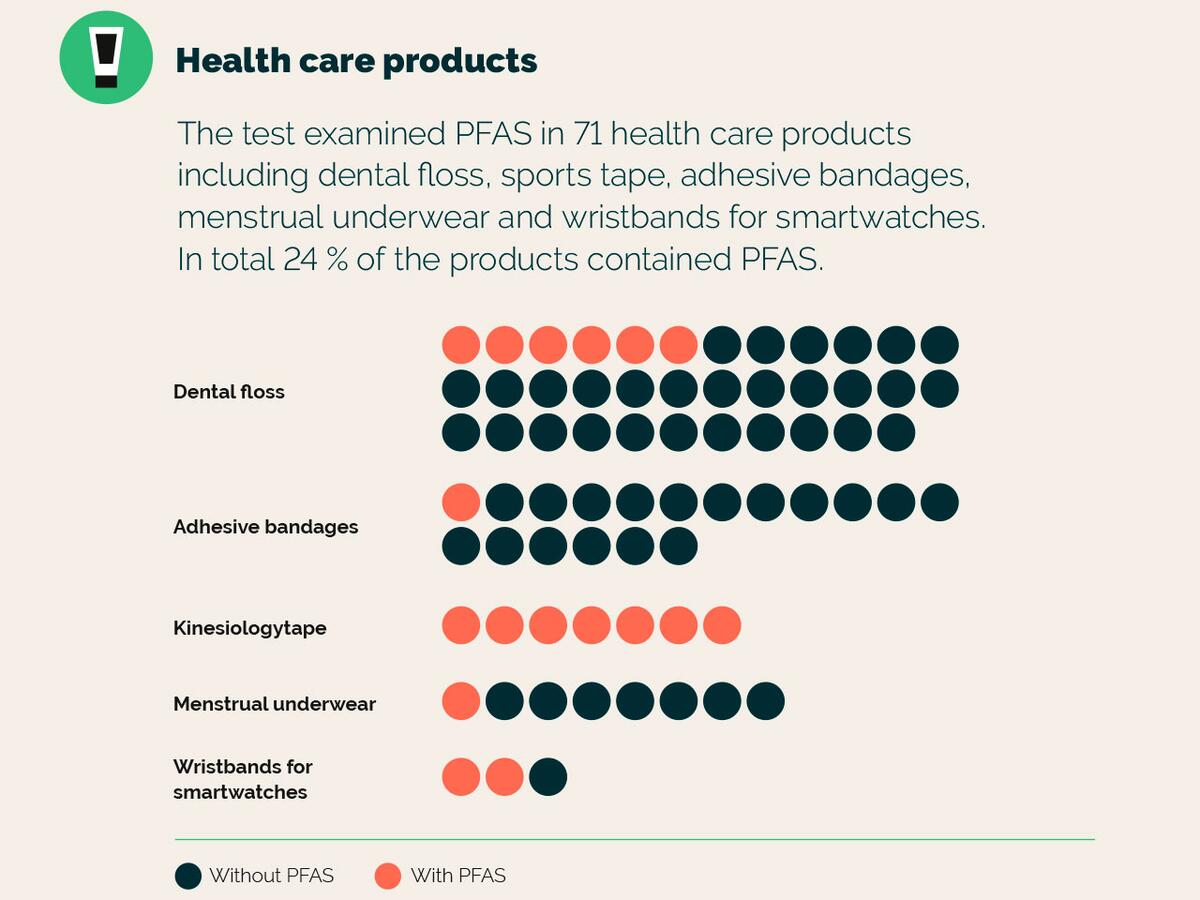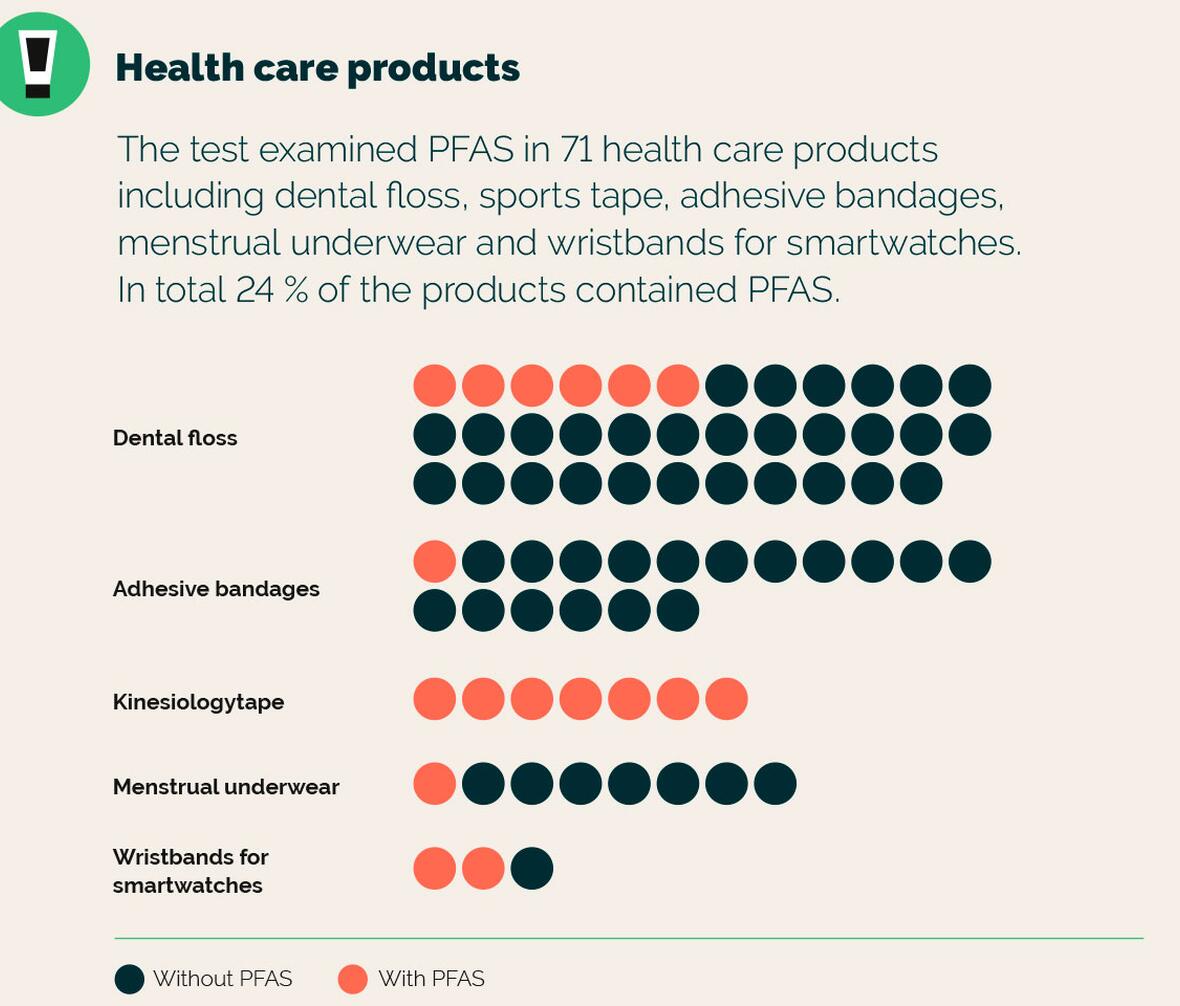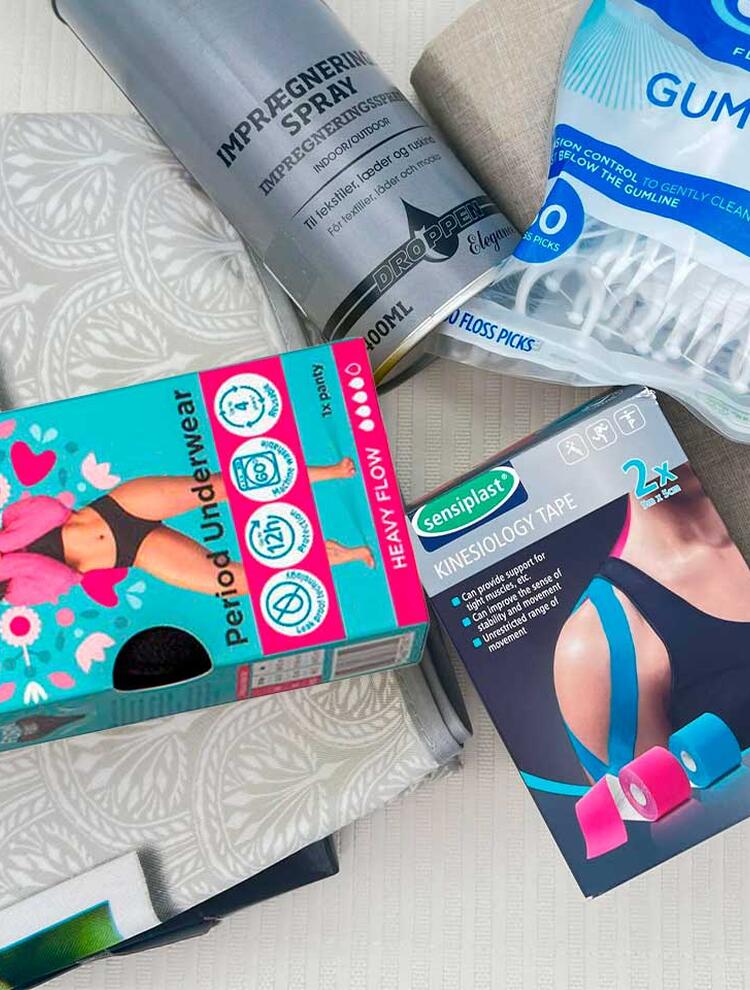
New findings of PFAS in a wide range of products from dental floss to air fryers
PFAS can hide in tablecloths, pillows, watch straps, dental floss, sports tape and air fryers. A European test shows that 28 percent of a wide range of products contain the harmful substances.
The public concerns about PFAS grew in 2021 in Denmark after high levels of PFAS were found in cow meat. Then PFAS were detected in feed for organic chickens, and organic eggs were temporarily removed from the shelves. Most recently, attention has been drawn to PFAS contamination from a Teflon factory in northern Zealand.
One of the sources of PFAS contamination is the long-standing use of the water and dirt repellent substances in a wide range of products from dental floss to non-stick kitchenware. The consequence? These substances accumulate in nature and in our bodies, where they increase cholesterol levels, affect the immune system, cause kidney damage etc.
To shed a light on the problem The Danish Consumer Council THINK Chemicals in collaboration with 7 European consumer organisations, as well as a Canadian one, have tested 228 products for their content of PFAS. PFAS were found in 28% of the tested products.
PFAS for cooking, running and furniture
PFAS are present in a lot of everyday products: when preparing food in the air fryer, rinse your teeth or lay the table.
"It is concerning how many different products contain PFAS. This can have consequences for consumers directly through use, but certainly also through the pollution of our environment. The test shows that PFAS are not necessary at all and that products without PFAS exist – and that is where we want to go, and preferably as quickly as possible," says Stine Müller, project manager at the Danish Consumer Council THINK Chemicals.
The results also surprise the member of the European parliament Christel Schaldemose:
“The study is both alarming and very concerning. When we still find PFAS in products – even substances that have been banned in the EU for years – it is a clear sign that not enough has been done to protect consumers. It is simply not good enough” she says.
Are there any regulations for PFAS?
It is estimated that up to 12,000 PFAS substances exist. Some are illegal but most are not: Some PFAS substances are illegal in the EU and have been under restriction for a long time. This is fx. PFOA and PFOA related substances. Other PFAS substances will be banned in 2026. As an example, there will be an EU ban against specific substances such as PFxHA in all products.
A ban on all PFAS in clothing, textiles, and textile impregnation is also on the way in Denmark. It will take effect on July 1, 2025, with a one-year phase-out period.
Denmark already has a national ban on the use of PFAS in paper and cardboard for food packaging, and EU is set to introduce a broader ban on PFAS in all types of packaging, including food contact materials, starting in 2026.
Finally, there is a proposal from 2023 for a complete ban of all PFAS substances for all purposes, which is still currently being processed by the EU.
Kitchen products
14 percent of the tested food paper products contain the PFAS 6:2 FTOH, which will be banned by the EU from 2026. In Denmark, the national ban against PFAS in paper and cardboard intended for food contact has been enforced since 2020. Most of the Danish products in the test complies with the national ban, while PFAS are primarily found in the food paper products from other European countries.
Parallel imported popcorn bags
Three of the 10 popcorn bags in the test contain PFAS. One was bought in Denmark, despite the national ban against PFAS in paper and board food contact materials. It concerns a version of Popz microwave popcorn, bought at Partyking.dk, which according to Popz Denmark is parallel imported and not allowed to sell on the Danish market, due to the PFAS ban.
So, the popcorn bag found its way to the Danish consumers through parallel import. Popz Denmark has further informed that the products they market, e.g. in the supermarket chains, comply with the Danish legislation and are without PFAS. The seller of the product, Partyking.dk, have informed us that they will no longer be selling the popcorns to Danish consumers.
No air fryers without PFAS
PFAS may be contained within the non-stick coating of air fryers and unfortunately, we did not find any air fryers, without PFAS, in the test. All the six tested models contained PFAS.
”Air fryers do not reach the temperatures required to release PFAS from the coating. If you own an air fryer with PFAS, you do not have to replace it. But if you buy a new air fryer, we recommend searching for one without PFAS although the test shows that it can be difficult to find. There is a great need for manufactures of air fryers and non-stick cookware in general to stop using PFAS in the coatings”, says Stine Müller.
No PFAS in Tea bags
We also tested eight tea bags of which none contained PFAS. Tea bags were included in the test because previous findings of PFAS in tea bags have been reported.
Household textiles
Of the 55 kitchen and household textiles a little less than half, or 44 percent, contain PFAS. Impregnation sprays are another product category with PFAS containing products. In addition to this, we also tested 15 mattress protectors and five potholders where we did not find any PFAS.
Tablecloths, aprons and cushions with PFAS
Especially tablecloths, aprons and pillows for both outdoor and indoor use contain PFAS. A lot of the products are marketed as water and dirt repellent.
Impregnation as an airborne contaminant
Impregnation sprays may contain PFAS to make couches, shoes etc. water and dirt repellent. Six of nine impregnation sprays in the test contain PFAS, which you may risk inhaling as you apply the spray.
Three of which are from the Danish market. These products are not allowed to contain PFAS from 2026, because they are a part of the Danish ban against PFAS in clothes, textiles and impregnation products.
Health products
In the test dental floss, sports tape, plasters, menstrual panties and wristbands for smart watches were investigated.
Dental floss may still contain PFAS
Dental floss can be made from a substance called PTFE, which is a PFAS.
A total of 35 different dental floss products have been tested, of which six contain PFAS. Seven of the dental floss products are sold on the Danish market and two of these contain PFAS. One of them is from Oral B and according to them it is parallel imported to the Danish market. The manufacturer has further informed that the content has been changed and no longer contains PFAS.
The Danish Consumer Council has previously asked companies whether their dental floss contained PFAS. Several companies stated that they were in the process of phasing out PFAS.
All Sports tapes contain PFAS
Sports tape or kinesiology tape are typically water and dirt-repellent, and this is where PFAS becomes relevant.
All the seven tested sports tapes contain PFAS, and they contain amounts above the permitted limit.
Regular medical plasters were also included in the test. Previous findings from an American test found PFAS in plasters. That was not the case in this test. Only one of 16 plasters contained PFAS. The plaster was bought from Amazon.
PFAS in straps for smart watches and fitness trackers
An American study previously found PFAS in straps for smart watches and fitness trackers made from fluororubber - which is a PFAS.
Three smartwatches were included in the test, two of which contained PFAS and one without.
One pair of menstrual panties contain PFAS
Menstrual underwear may be one of the products that you would not expect to contain PFAS. But previous studies find that it is possible to find PFAS in this type of product.
In our test a total of eight menstrual panties were tested and while most did not contain PFAS, one pair did.
PFAS in products end up in nature
If your brand-new smartwatch or the dental floss in your bathroom contains PFAS, this is not in itself the major problem.
The core issue with PFAS relates to the production of all the PFAS containing products:
First, PFAS are produced in a factory and subsequently used for production of the particular products. During both steps, the non-degradable PFAS can pollute the environment, eventually ending up in our foods and water. On top of that, use of some of the products can also lead to direct exposure to PFAS.
Illegal substances appear
It is highly concerning, when nine percent of the tested products contain PFAS substances which are already illegal within the EU and especially when the concentration of these substances in the products are high. This goes for PFOA related substances, among others, which have been banned for years due to their recognized harmful effects on humans and the environment.
The head of office in the Chemicals Agency of the Danish Protection Agency, Kim Holm Boesen, take this issue very seriously:
”Overall, The Ministry of the Environment places very high priority on the issue of PFAS, which is also reflected in the broad political agreement on a national action plan on PFAS from 2024. This is also why the Danish Environmental Protection Agency takes the findings of illegal PFAS substances very seriously and continues its efforts to monitor regulated PFAS substances in many types of products and chemical mixtures, including consumer products” he explains, and adds:
“The Chemical Inspection Service conducted multiple inspections of PFAS in 2024 of fire suppression foam and cosmetic products among others and is currently conducting inspections of a range of chemical mixtures such as impregnation sprays and car care products. In 2025 the Inspection will continue it’s PFAS efforts, e.g. on PFAS in household textiles and firefighting foam”, says Kim Holm Boesen.
The battle of an EU ban
Many countries - including Denmark - have pushed for a total EU ban on PFAS, but nothing has been adopted yet. According to Christel Schaldemose, the efforts are still ongoing.
”Overall, The Ministry of the Environment places very high priority on the issue of PFAS, which is also reflected in the broad political agreement on a national action plan on PFAS from 2024. This is also why the Danish Environmental Protection Agency takes the findings of illegal PFAS substances very seriously and continues its efforts to monitor regulated PFAS substances in many types of products and chemical mixtures, including consumer products” he explains, and adds:
“The Chemical Inspection Service conducted multiple inspections of PFAS in 2024 of fire suppression foam and cosmetic products among others and is currently conducting inspections of a range of chemical mixtures such as impregnation sprays and car care products. In 2025 the Inspection will continue it’s PFAS efforts, e.g. on PFAS in household textiles and firefighting foam”, says Kim Holm Boesen.
